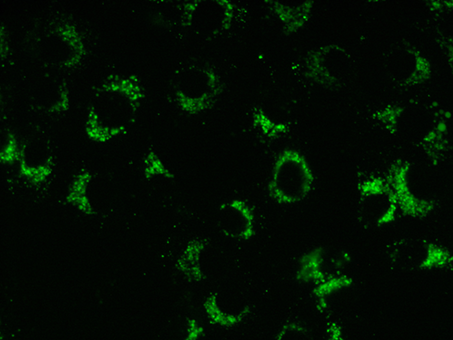
Although the secretory function of the endoplasmic reticulum (ER) is well documented, little is known about reverse pathways which transport extracellular molecules from the plasma membrane to the ER. These pathways maybe particularly important in the ER stress induced apoptosis, or in the homeostasis of cholesterol, for which receptor molecules are located within the ER. ER-mediated phagocytosis is another example of ER targeting from outside the cell that has been recently proposed as an adaptation of intracellular pathogens to avoid destruction in host cells.
To investigate the internalization of an extracellular lipid vesicle we made use of phosphatidylethanolamine(PE)-based fusogenic liposomes with ubiquitous uptake in mammalian cells and found that all cells had in common a progressive accumulation of the encapsulated cargo in the ER. In an attempt to characterize this perinuclear organelle by preserving intact the subcellular structures we constantly avoided the use of cell fixation, reported to induce artefacts. This might have been an important issue that could explain why that particular ER targeting pathway has not been found before, despite the intense scrutiny of the liposome delivery routes.
We found that lipid vesicles are internalized by both clathrin-mediated and clathrin-independent endocytosis pathways which require an acidification step for liposomes destabilization and fusion with the endosomes. The fusion event possibly triggers a microtubule driven pathway which avoids classical sorting endosomes and favours an ER pathway. This is an alternate to the SV40 virus caveolar route using a pH dependent, direct plasma membrane-to-ER pathway to efficiently deliver extracellular encapsulated cargo to the ER. Whilst further studies are needed to dissect this novel pathway in more detail, the finding of a second major ER targeting route leads to the idea that the import of molecules from the outside cell into the ER could be as important for the cell function as its secretion processes.
These findings add to the extensive use of liposomes as drug delivery carriers, by proposing this new ER delivery route. This pathway may be used to specifically deliver to the ER drugs encapsulated in fusogenic PE-based liposomes.
"Encapsulated cargo internalized by fusogenic liposomes partially overlaps the endoplasmic reticulum",
J.Cell.Mol.Med.., 13 (9b), 3110-3121 (2009)
Mustata RC, Grigorescu A, Petrescu SM
"pH-sensitive liposomes are efficient carriers for endoplasmic reticulum-targeted drugs in mouse melanoma cells",
Biochem.Biophys.Res.Commun., 293(3), 918-928 (2002)
Costin GE, Trif M, Nichita N, Dwek RA, Petrescu SM